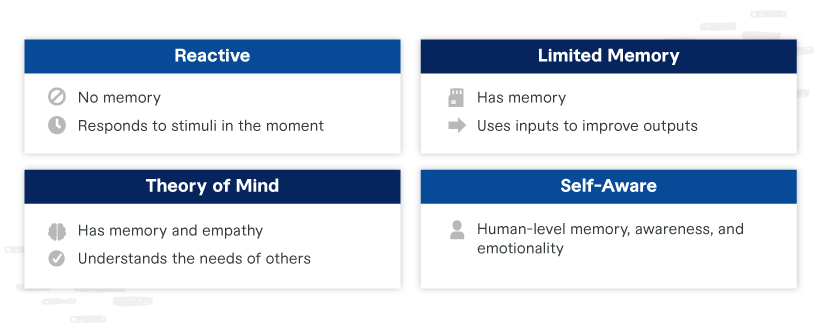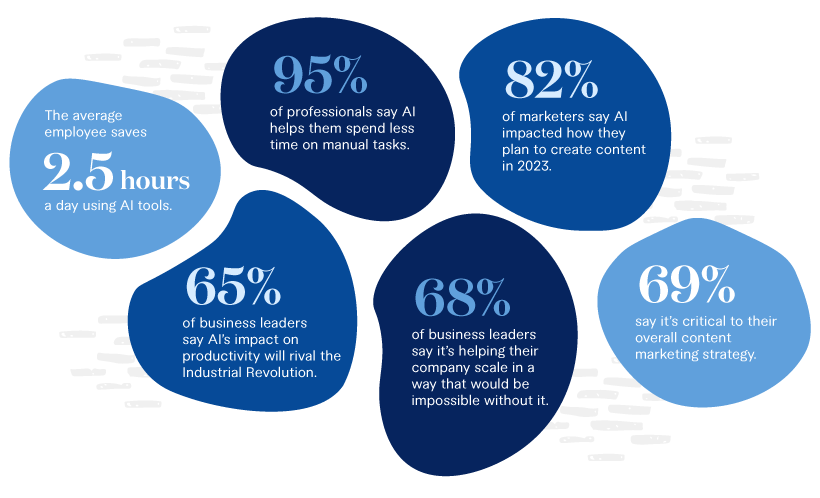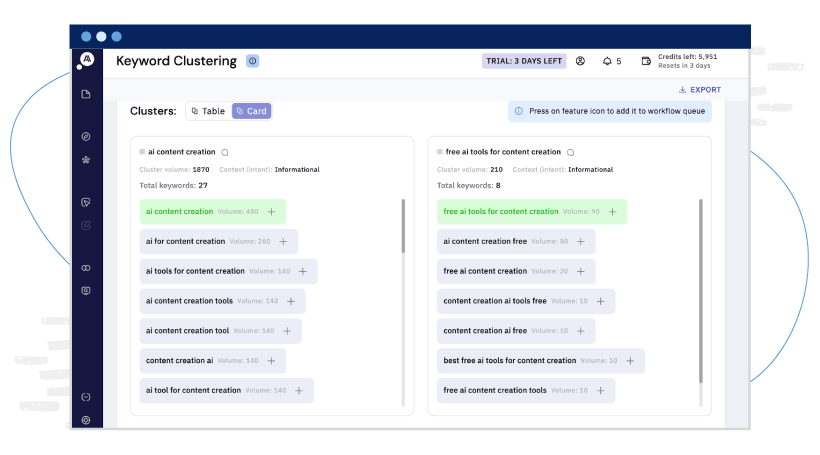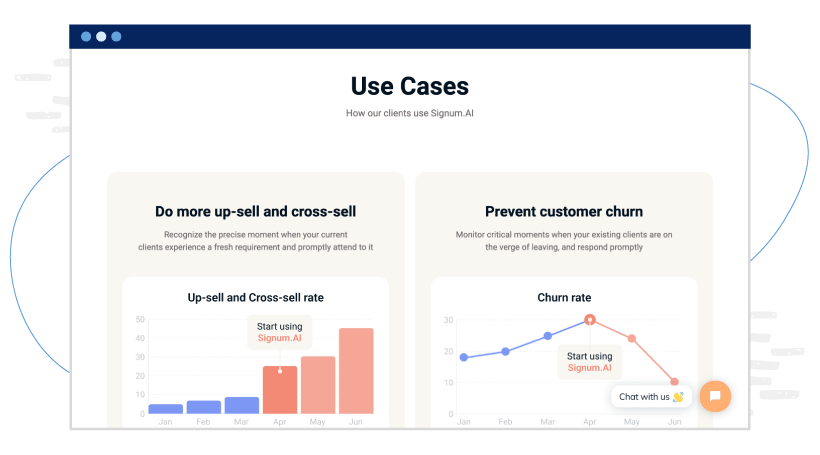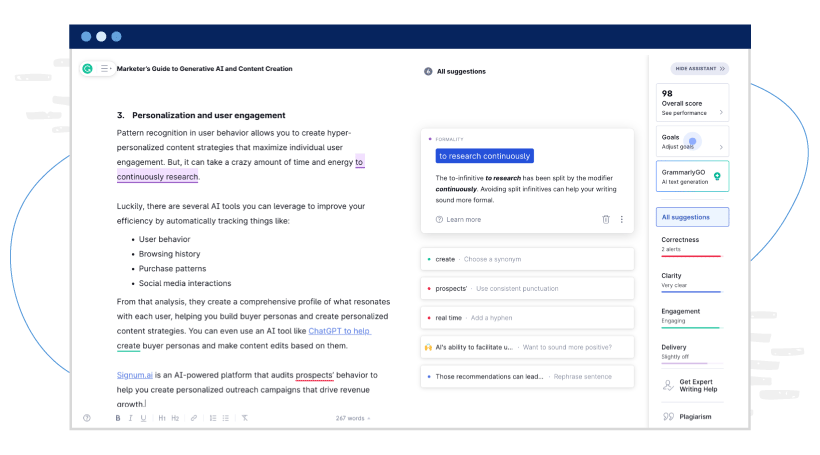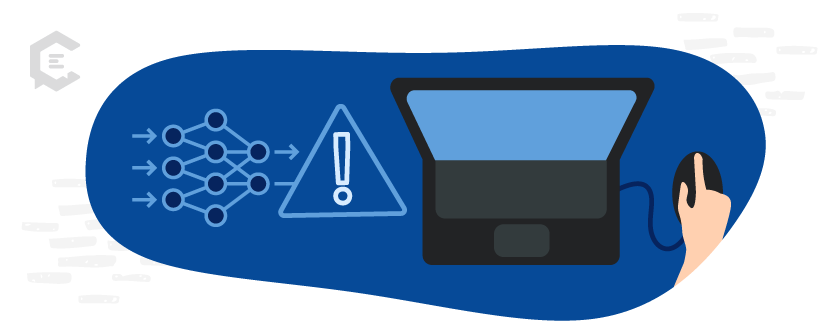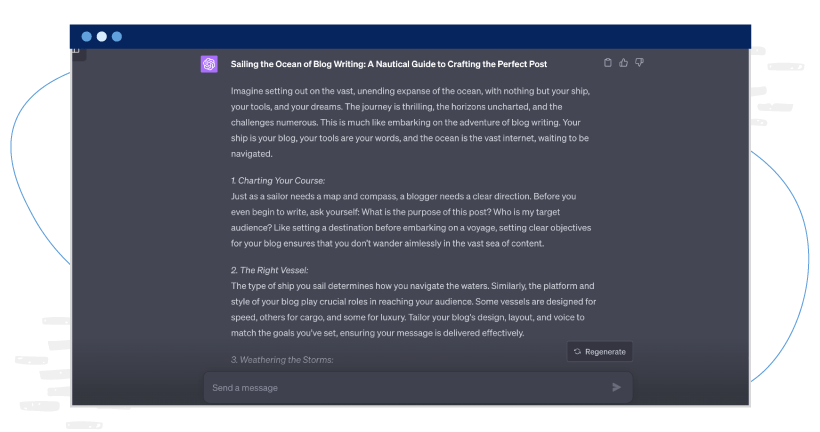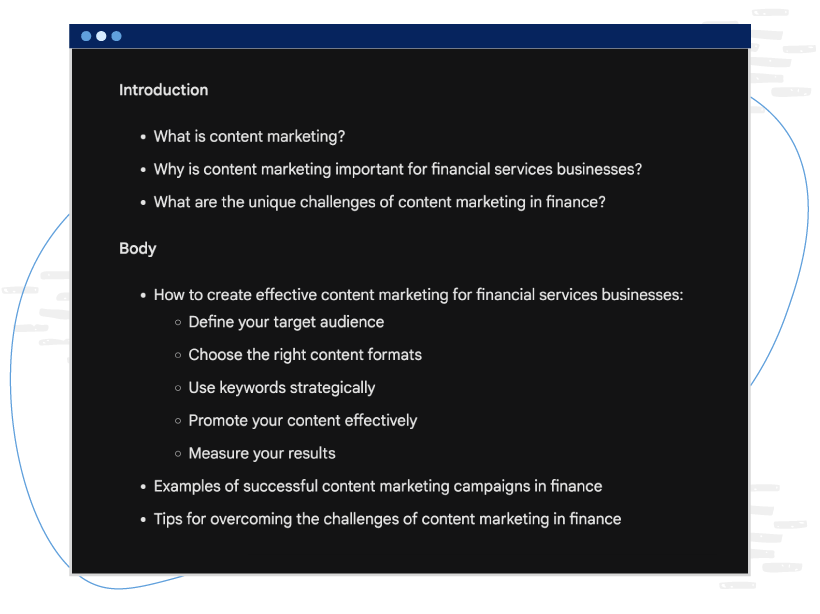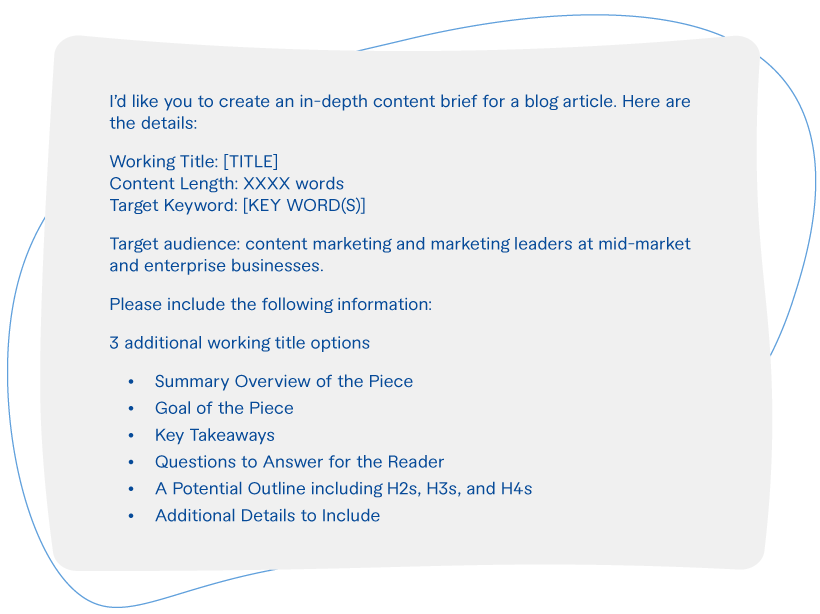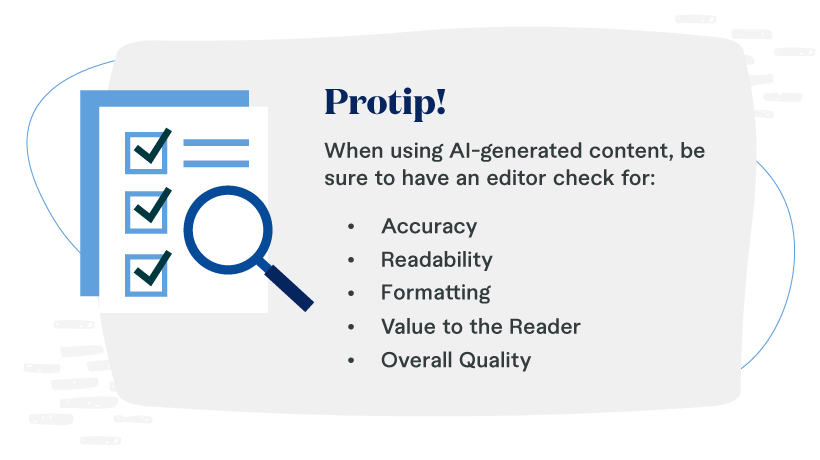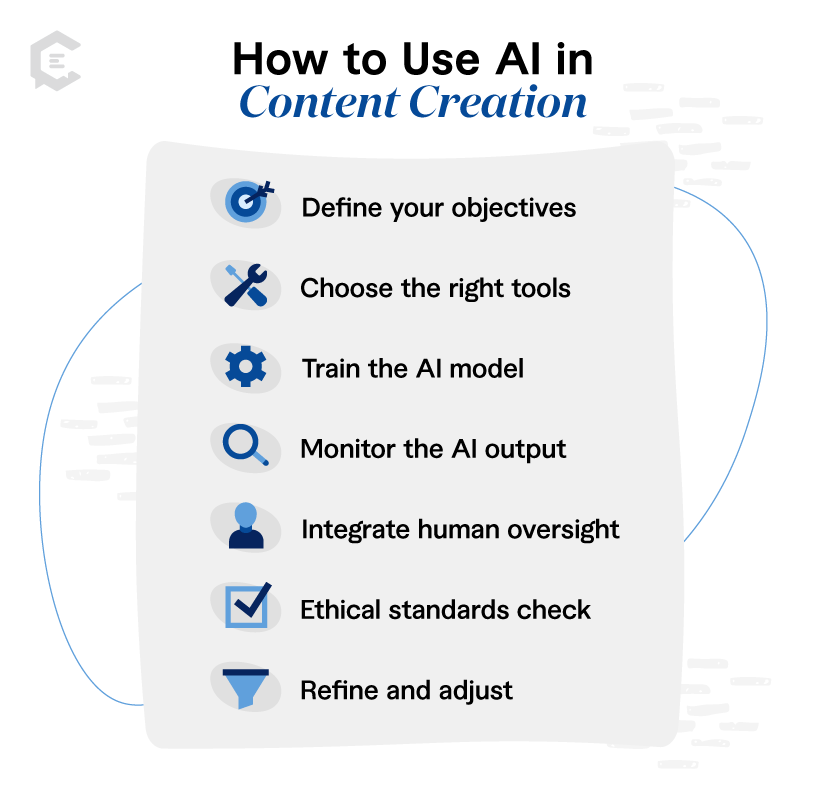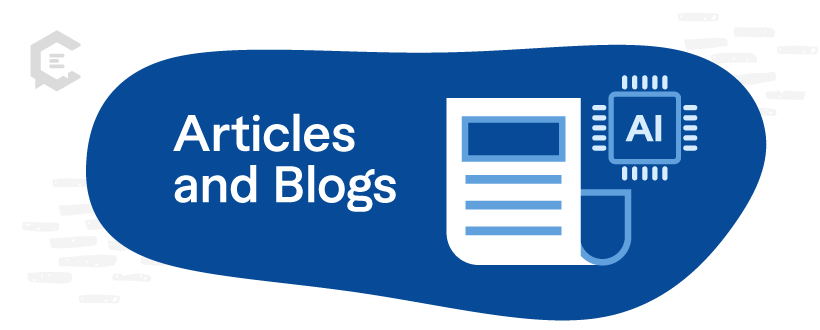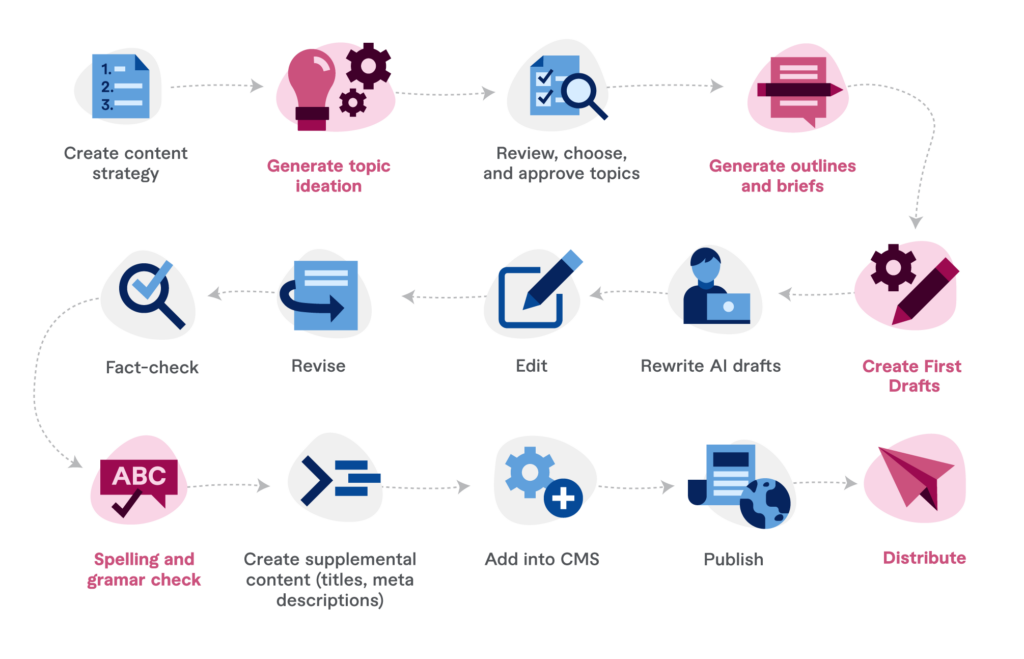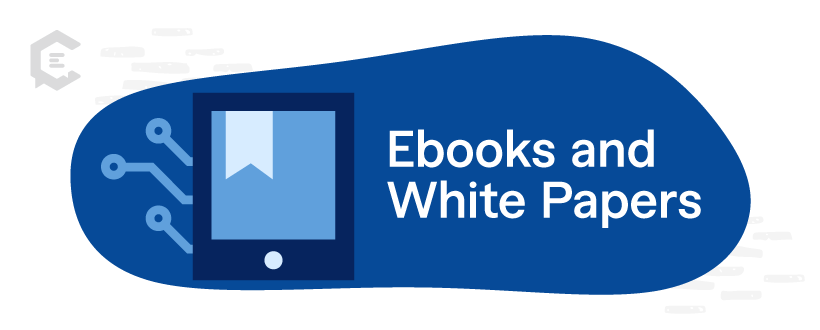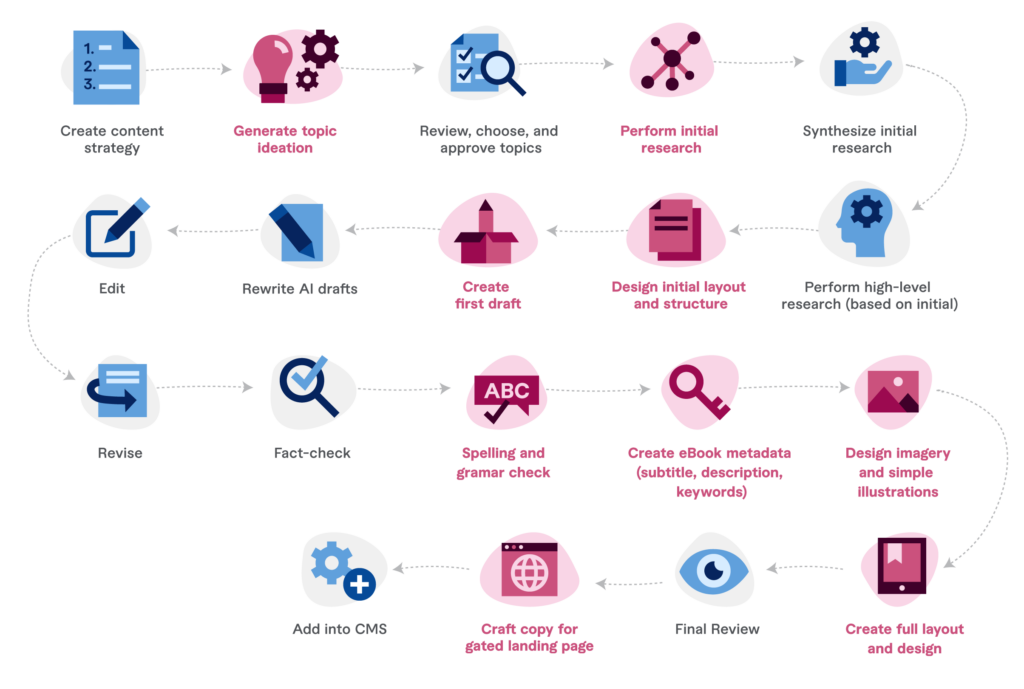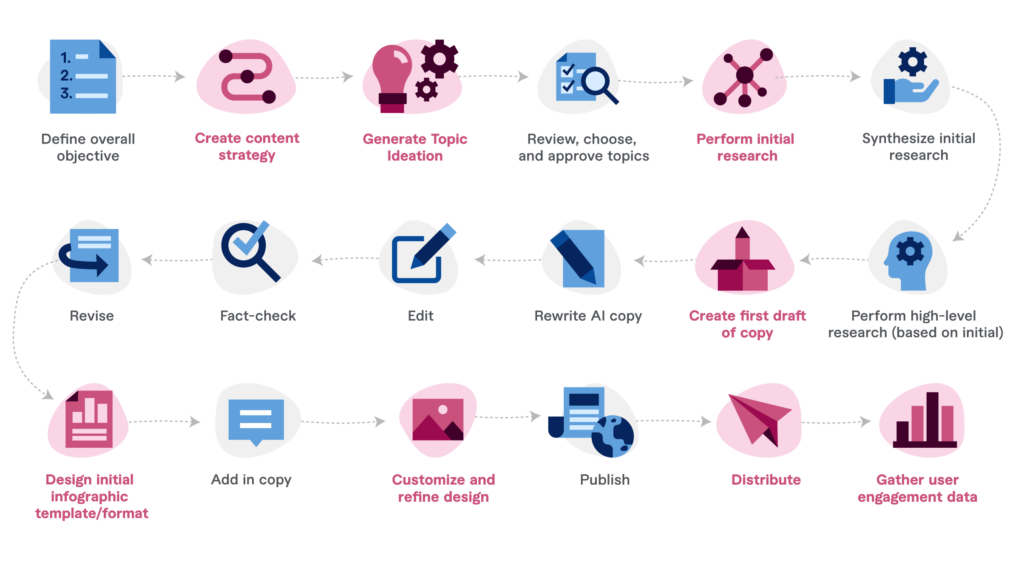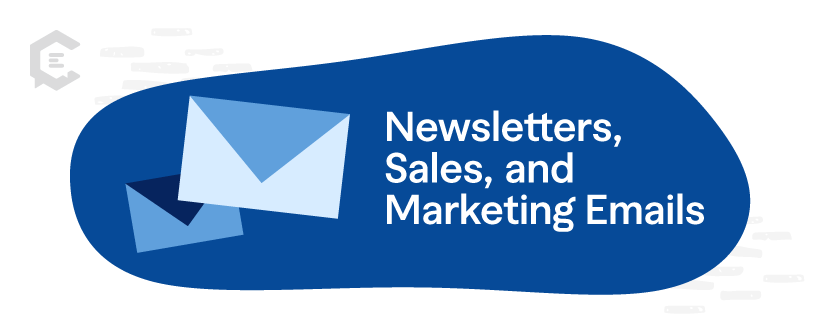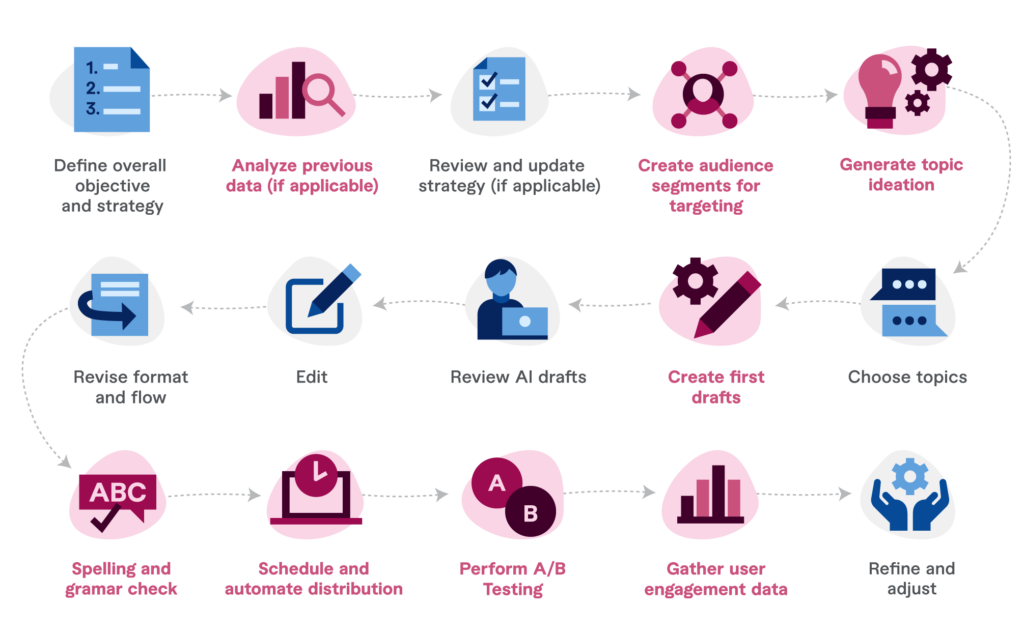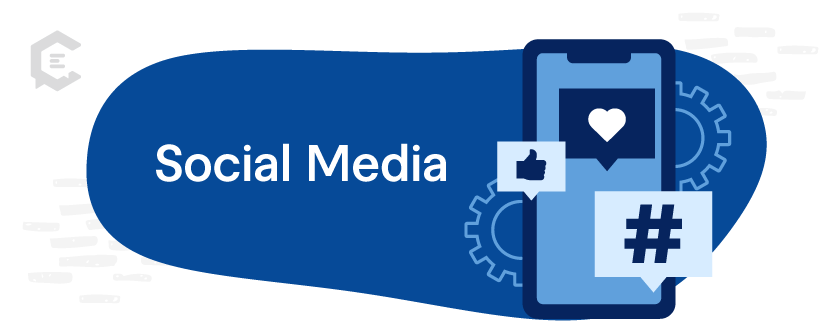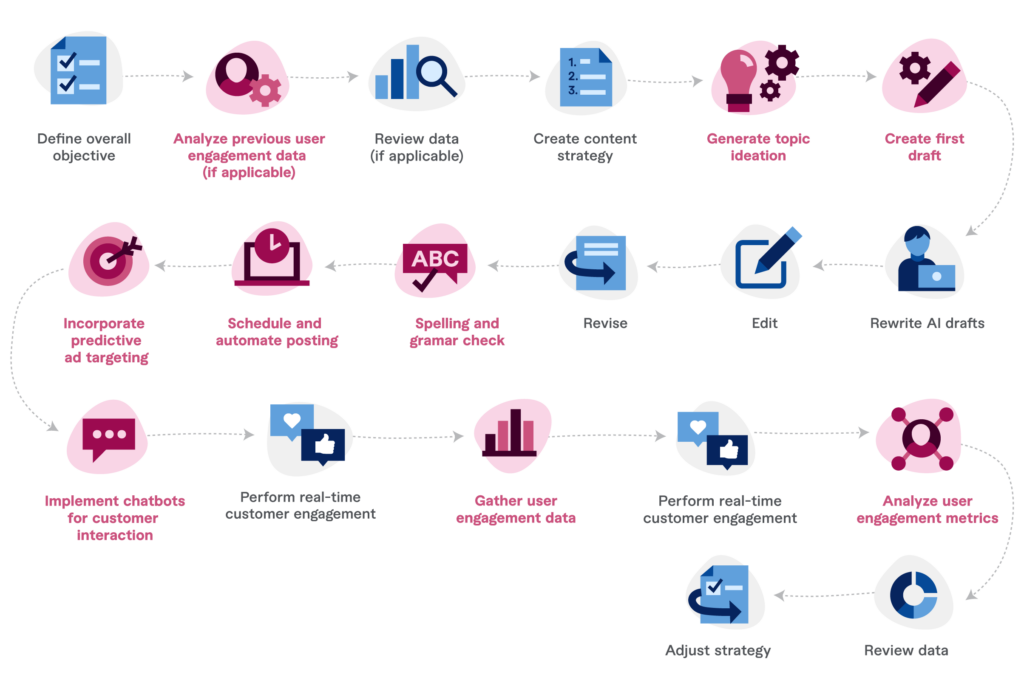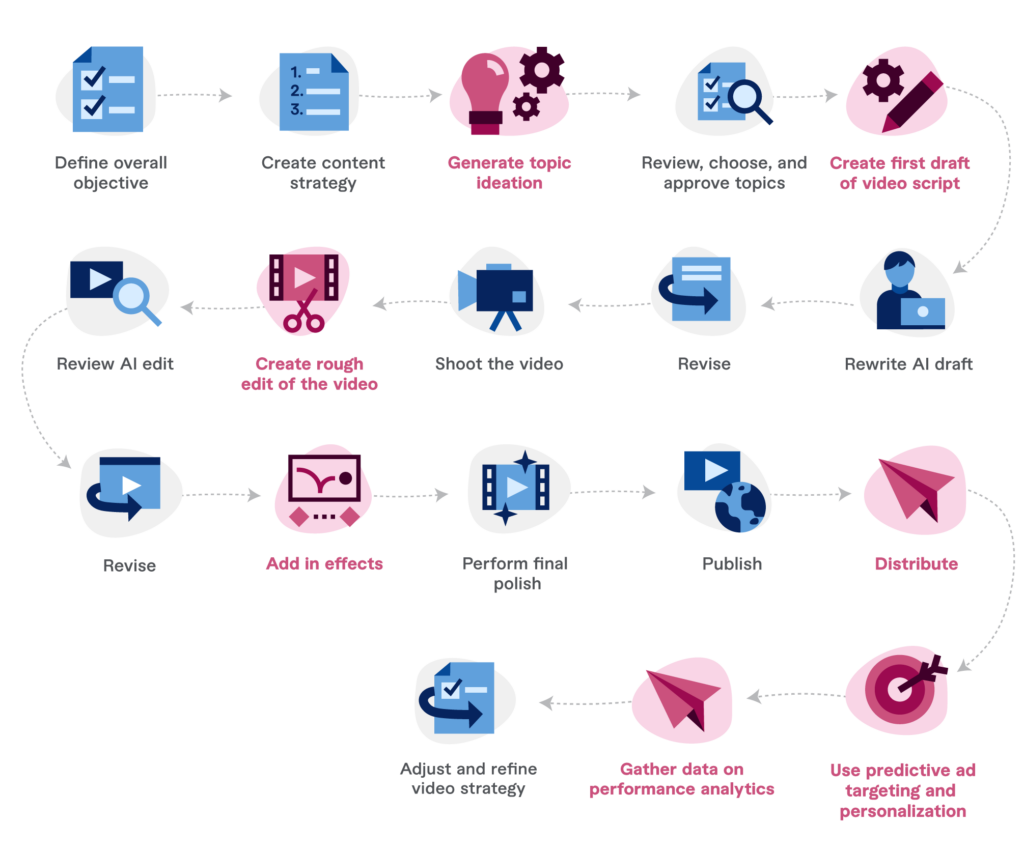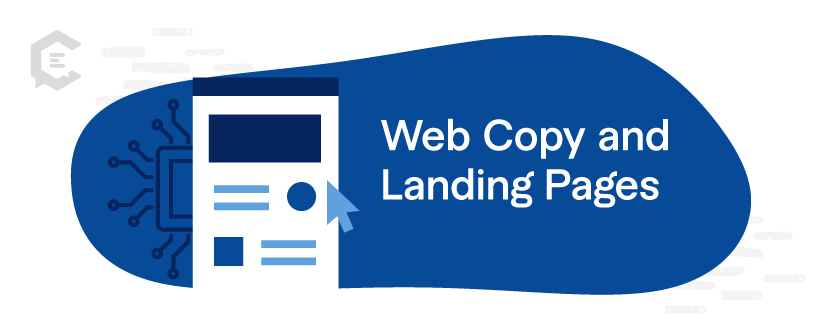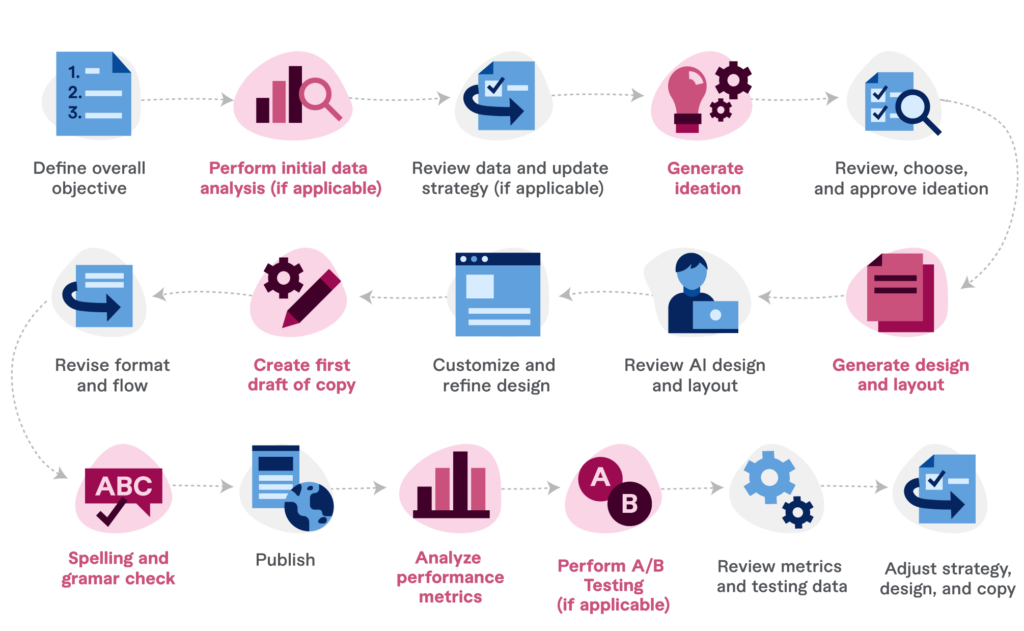Recently, one of our ClearVoice customers came to us and said:
“We want to create 20,000 pieces before Thanksgiving using AI, but they have to be of the highest quality. Can you help us?”
That’s no small feat even for the ClearVoice service delivery team, which has honed a content production process from over a decade of experience producing hundreds of thousands of pieces of content.
We could say ‘yes’ as we had already laid out a method for providing expert, human editing to AI-generated content so it passes the ‘written by human’ sniff test because our expert writers and editors refined it.
In this comprehensive guide, we’ll dive into how we approach AI-driven content, the benefits and risks, and how to leverage the available technologies effectively. We’ll also explore how to best use AI to enhance specific content types and finish with a step-by-step guide for employing AI in your content strategy.
A Quick Primer on AI
There are a lot of technologies that are housed under the general term artificial intelligence or AI. A deep understanding of each is not necessary for a marketing professional, but for those interested, we wanted to break it down.
Broadly, artificial intelligence is a machine learning computer technology that performs tasks usually reserved for human intelligence, like problem-solving and natural language processing. There are four types of AI:
- Reactive – Responds only to different stimuli. No memory or learning.
- Limited Memory – Uses memory and data inputs to improve responses and outputs.
- Theory of Mind – Intelligent and empathetic; understands other intelligent systems.
- Self-Aware – Self-aware and human-like.
Most of the current technology on the market and that you’ll use as a marketer sits firmly in the ‘Limited Memory’ type of AI. It uses inputs and data to learn how to create better responses but doesn’t use any sort of empathy or understanding to craft the output.
The most common AI used in content creation is Language Learning Models (LLMs), which are essentially AI models that work with language. OpenAI’s ChatGPT and similar technologies are currently built on LLMs for the written outputs they produce. As generative AI, LLMs, and other AI models mature, there is always a new ramping period as the latest model comes up to speed with the learning inputs it receives.
Importance of AI in Content Marketing
You can’t turn around in-store these days without someone talking about how AI is everywhere. The same holds true in content marketing circles.
AI is one of the most significant developments in content marketing history, transforming how we approach content creation and distribution. Automating low-level tasks is just the beginning.
Not only can AI quickly recognize user patterns and behavior to inform your content strategy, but it can also personalize content to match those behaviors. And businesses are taking note of the power of these tools.
In fact, 91% of leading businesses have an ongoing investment in AI. Additionally, HubSpot reports:
- 95% of professionals say AI helps them spend less time on manual tasks
- 82% of marketers say AI impacted how they plan to create content in 2023
- 69% say it’s critical to their overall content marketing strategy
- 68% of business leaders say it’s helping their company scale in a way that would be impossible without it
- 65% of business leaders say AI’s impact on productivity will rival the Industrial Revolution
- The average employee saves 2.5 hours a day using AI tools
With those kinds of numbers, it’s clear the AI revolution has begun. As that revolution transforms your business operations, it’s essential to implement a human oversight strategy to harness AI’s full power. But first, let’s get more specific and talk about how critical of a tool it can be for content creation.
5 Benefits of Using AI in Content Creation
The key to using AI in content creation is understanding where it excels and where it fails. For example, AI is fantastic for automating low-level tasks and data analysis. However, it lacks quality in actual content creation because it can’t replicate human creativity and emotion.
AI needs human oversight at all steps of the process. Most AI tools you’ll use in your content marketing efforts require high-quality prompts that help guide the AI model in your desired output. Then, you’ll have to double-check everything it generates to ensure the content is unique, valuable to the reader, and accurate.
Let’s dive into how AI can elevate your entire content apparatus.
1. Streamlined productivity
Many content marketers aim to enhance productivity — from strategy to content writing to distribution. According to a HubSpot survey, most marketers currently use AI for ideation. Many AI tools can generate anything from suggested keywords to blog topics in seconds.
For example, Keyword Insights quickly generates thousands of SEO keywords, even grouping them into topical clusters. Now, hours or days of research are done in minutes. Other tools like HubSpot’s AI content assistant instantly create large lists of blog topic ideas.
Image Source: Keyword Insights
But AI’s capabilities don’t stop with ideation. Other ways the technology supports content creation include
- Outlines and assignment briefs
- SEO titles and meta descriptions
- Image alt texts
- Summaries
- Basic first drafts
2. Advanced analytics and data-driven insights
Marketers can use AI to track the performance of individual pieces of content across different platforms. Data visualization AI software, like Tableau, analyzes performance indicators such as reach, impressions, and conversion so you can refine and optimize your content in real-time.
Staying on top of your content inventory is critical to ensuring your content keeps working for you well past the publish date. With Polymer, you can upload a spreadsheet of your content assets, and it can instantly transform it into a streamlined database, making managing your content a breeze.
Finally, one of AI’s most remarkable capabilities is predictive analytics. With tools like Qualtrics, marketers can build accurate predictive models of user behavior to forecast future patterns and then understand content will most likely resonate with the audience.
3. Personalization and user engagement
Pattern recognition in user behavior allows you to create hyper-personalized content strategies that maximize individual user engagement. But, it can take a crazy amount of time and energy to continuously research.
Luckily, there are several AI tools you can leverage to improve your efficiency by automatically tracking things like:
- User behavior
- Browsing history
- Purchase patterns
- Social media interactions
From that analysis, they create a comprehensive profile of what resonates with each user, helping you build buyer personas and create personalized content strategies. You can even use an AI tool like ChatGPT to help create buyer personas and make content edits based on them.
Signum.AI is an AI-powered platform that audits prospects’ behavior to help you create personalized outreach campaigns that drive revenue growth.
It monitors and tracks user behavior changes, from keyword mentions to job changes to page views. That monitoring pinpoints exact moments when your contacts may need something new, providing opportunities for up-sells. It also helps mitigate your churn rate by flagging crucial moments when your clients may consider leaving your business.
Image Source: Signum.AI
Signum.AI also has content customization features built-in, where you can automatically generate and scale uniquely personalized content. That powerful combination lets you engage with users in real-time as they evolve.
AI’s ability to facilitate user engagement isn’t just limited to outreach. A tool like Recombee uses its AI-powered content recommendation engine to analyze user behavior and generate real-time personalized content recommendations. Those recommendations can lead to more time spent on your website, increased page views and click-through rates, and, ultimately, more conversions and revenue.
4. Improved content quality and consistency
Memorable brands all have one thing in common: consistency. This extends beyond always ensuring you use the same color of red in your visual communications or having a great logo. Infusing your brand tone and style consistently throughout your content builds a foundation of trust and authority.
AI can help here as well!
You can train AI models to understand the tone and style of your brand voice and then use the tool to audit existing content to assess its quality, relevance, and alignment with your brand guidelines.
Other tools help ensure brand consistency by generating multi-format content within the same workflow, all while maintaining your brand voice. For example, Breeze Content Agent helps you generate blog posts, landing pages, and even podcast scripts.
AI also has your back when it comes to enhancing readability, checking grammar, and proofreading. Tools like Grammarly can perform grammar checks, readability analysis, plagiarism review, and SEO optimization.
Image Source: Grammarly
Others, like Hemingway, analyze your content’s readability level and pinpoint specific areas in the copy that need improvement. Harnessing these capabilities enhances your content quality across the board while ensuring consistency.
5. Cost-effectiveness
With the proper process, you can save time and money with AI supporting your research, content ideation, and even content generation (at least the outlines and first drafts). 75% of marketers say generative AI helps them create more content than they would without it.
Predictive analytics and insights also bolster your content strategy. As AI marketing tools analyze what’s working and what’s not more efficiently, you can ensure your resources are spent in the right place, leading to better ROI.
AI-driven tools and platforms also unlock scalability in ways never seen before in content marketing. With the right prompts, your ideation, briefing, and production are enhanced, even if it still requires a human touch for strategy and review. You can analyze larger amounts of marketing data without taking days to build your models. And, as syndication and content promotion platforms integrate more AI models, your brand visibility with content will also expand.
6 Risks of Using AI in Content Creation
We’ve mentioned some good; now let’s look at some of the risks and challenges of integrating generative AI tools in your content creation.
1. Low-quality content
All AI models available to content marketers are still the Limited Memory type of AI. Remember, these models are trained to operate on patterns but not provide meaning or emotional understanding. Sometimes it’s okay. Sometimes, it’s way off.
AI is also guilty of creating repetitive content that creates redundancy within the writing (sort of like this sentence). In April 2023, our ClearVoice content marketing team ran an AI content production experiment, and it generated repetitive content for numerous different prompts even though the prompts were varied.
Finally, many content marketers find that AI returns low-quality writing with clunky sentences, strange word choices, and unclear meanings. A few tools we’ve used generated copy with wacky metaphors and sentence cadences. For an article on content creation, AI used an odd metaphor about a symphony orchestra. Another time, it tried (and failed) to equate blog writing to sailing a ship on the ocean.
Image Source: ChatGPT
2. Inaccurate content
Even if you feed AI robust data and prompts, AI models may still produce erroneous information. These are called “AI Hallucinations,” where AI confidently generates a response that isn’t true. Hallucinations can range from faulty data examples to fabricated stories, quotes, and case studies presented as fact.
Don’t be like lawyer Steven Schwartz, who presented fake cases as precedence after using ChatGPT to conduct his research for his case Mata vs. Avianca Airlines. Perhaps sharing incorrect or even made-up information from an AI tool won’t cause you to face court sanctions; depending on your industry, it can lead to other legal issues and, at the very least, damage your brand.
3. Prompt issues
Prompts are challenging to master, and the biggest risk is ambiguity, as AI models struggle when prompts lack context and clarity. There are many prompting guides circulating on social media, and these provide a great foundation. However, your brand and content are unique, so human involvement when prompting is essential.
For example, prompting Google’s Bard AI writing model with “Write an outline for an article about content marketing in finance” returns a vague and abstract outline.
Image Source: Bard
But, if you fine-tune the prompt to “Write a detailed outline for a 1,000-word article targeting mid-level financial marketing teams on how content marketing increases user engagement in finance,” Bard now has more specific parameters to guide it. Head over to Bard and see for yourself what it produces when you enter that prompt.
The critical thing to remember is that prompts also depend on the data you’re training the AI model on. If the input data is biased, flawed, or inaccurate, the AI’s output will reflect that. Bad input means bad output, regardless of how well-crafted your prompt is. It’s essential to have a strong AI prompting strategy to ensure you’re getting the highest quality response out of your AI tool.
Here is one of our favorite prompts for creating assignment briefs for the ClearVoice blog:
4. Copyright and plagiarism
One of the most significant risks when looking at the ethical concerns of AI in content creation relates to copyright and plagiarism. AI generates copy using vast amounts of information based on learning inputs, which includes the works of others. AI doesn’t inherently recognize copyright boundaries or licensing requirements. There’s a sizable risk that its output inadvertently leads to plagiarism.
And because the laws and rules around AI-generated content are still in flux, there are no clear boundaries. However, a recent ruling from U.S. District Judge Beryl Howell stated that AI-generated art cannot receive copyrights.
To mitigate your risk, it’s critical to include a human writer and human editor in your content creation process while using AI-detection tools such as CopyLeaks or Originality.ai. Not doing so can lead to all types of headaches. It can also cause your audience to lose trust and faith in your brand. And once your brand’s integrity is lost, it’s hard to get back.
5. Lack of the human element
Having a human touch is essential to keep the connection with your customers alive and thriving. AI can’t draw from personal observations or deep insights that a subject matter expert in the field has. Even when technically correct, AI-generated content lacks the personal perspective you need to establish your brand as a thought leader in your field.
If you use AI to generate content, at the very least, you must have an editor to review it. They should check for accuracy, repetition, readability, formatting, and overall quality. Editors can also add voice, personality, storytelling, and emotional elements. Better yet, have a writer rework the AI-generated content into something more valuable to the reader than the LLM’s output.
The bottom line: if you remove the personal touch and ignore human oversight, you lose one of marketing’s most fundamental aspects: human connection.
6. Losing the Expertise in Google’s E-E-A-T algorithm
Regarding AI content vs. Human content, there is one overarching rule: creating valuable content.
If Google doesn’t view your content as valuable to the user (this includes wanting writers to be industry experts with firsthand experience), your site may experience a drop in ranking and traffic. AI-generated content will generally not meet Google’s E-E-A-T guidelines without mindful edits from folks with the right expertise.
Also, according to Google’s Duy Nguyen, their search engine uses algorithms to detect pages with AI-generated content. In its quality rating guidelines, Google states that any content auto-generated without adequate originality will be marked as the lowest quality rating. Trustworthiness is the most vital component of their E-E-A-T algorithm.
That doesn’t mean Google is against all AI-generated content. You must ensure it’s proofread and fact-checked by writers who bring human insights and valuable expertise. ClearVoice can help!
How to Use AI in Content Creation
Implementing generative AI into your content creation strategy doesn’t have to be daunting. Here’s a step-by-step checklist to help you make the process smooth and efficient:
Define your objectives
Start by identifying what you want to achieve. Do you want to create more efficiency? Improve your content’s personalization? Scale production? Setting clear goals at the beginning lays the foundation for your AI-driven content production strategy.
Choose the right tools
Your goals will inform what tools you need. Look for tools that align with your needs and budget. It also doesn’t hurt to talk to experts or other businesses successfully integrating AI into their content strategies. Their insights can help you make the most informed decision for your brand.
Train the AI model
Now that you have the tools, it’s time to train the AI models. For example, if you’re using an AI writing tool like ChatGPT or Bard, this is the data you need to feed it:
- Your brand voice and style
- Who you’re targeting
- The parameters of what you want it to create
- Examples of content you want it to emulate
Then, you need to fine-tune its results through prompting.
 When Morgan Stanley wanted to educate other companies’ financial advisors on crucial issues around advising clients, they knew they had to generate helpful, engaging content. To help facilitate the process, they implemented a prompt strategy to train ChatGPT using a curated set of documents with necessary investment knowledge so the AI could reproduce content of equal quality. Read more here. When Morgan Stanley wanted to educate other companies’ financial advisors on crucial issues around advising clients, they knew they had to generate helpful, engaging content. To help facilitate the process, they implemented a prompt strategy to train ChatGPT using a curated set of documents with necessary investment knowledge so the AI could reproduce content of equal quality. Read more here. |
Monitor the AI output
AI training never stops. Build in time for regular audits and updates with new data into your content operations. This step will keep AI aligned with industry trends and your evolving needs. Also, continuously review your AI content for accuracy and consistency and revise it. Analyze your content’s performance and user engagement metrics and use these insights to adapt and make ongoing adjustments to enhance its effectiveness.
Integrate human oversight
While you can make some refinements with AI-automated tools, you’ll also need human oversight. Hire writers and subject matter experts to infuse AI-generated content with authentic human emotions, insights, and experiences. Use editors to double-check and refine the content and maintain the proper quality, accuracy, and style.
Ethical standards check
Another essential step is ensuring your content meets legal and compliance requirements, especially in certain industries like finance and law. Develop ethical-use guidelines for AI content and distribute them company-wide. Guidance should include responsibly using AI, respecting user privacy, and maintaining transparency with your audience. Stay up-to-date on copyright law and content ownership developments, and make sure your content adheres to them.
Refine and adjust
Once you’ve published your content, use AI analytics tools to pull performance and engagement metrics. These data-driven content insights, like conversion tracking, behavior analysis, and detailed demographic data, will give you the necessary information to refine your strategy continuously.
Mistakes to Avoid When Using AI
As you follow the checklist above, it’s essential to also watch out for the most common pitfalls that marketers fall into with AI. Here are the top five mistakes marketers need to avoid when using AI.
Using AI in Content Creation by Content Type
One of the essential aspects of any strong AI content creation strategy is knowing when to use AI for your content and how. Let’s dive into how you can implement AI in creating of each type of content.
Articles and blogs
The backbone of most content marketing strategies, this content provides a consistent and engaging way to connect with audiences, offer valuable insights, and position brands as thought leaders in their respective industries.
Where to use AI tools
- Ideating Topics: Streamline content ideation using the themes you’ve identified within your content strategy and effective prompts.
- Creating outlines and briefs: Save time using AI to assist in outlining the piece and helping flesh out broad information.
- Producing supplemental content: Quickly create derivative content such as social posts, SEO titles and meta descriptions, and email copy.
- Performing spelling and grammar checks: Edit and refine your content using tools like Grammarly after passing the content through a human editor.
Where not to use AI
- Storytelling and emotion: Leverage storytelling in your content to set your brand apart. AI cannot replace human creativity.
- Thought-leadership content: Thought leadership requires thought as well as in-depth perspective and experience.
- Sensitive or controversial topics: If your topic requires delicate handling, minimize your use of AI.
Helpful tools
- ChatGPT: ChatGPT can do it all – from ideation to outlining to derivative content. It can even generate basic first drafts and adjust to your style as you feed it data.
- Surfer: Surfer AI has a wide range of features designed to help push your content up the search engine rankings.
- Grammarly: If you’re a digital writer, you probably already know about Grammarly. If not, it’s time to start using it, as it is one of the best tools for analyzing and improving your writing.
- Hemingway: Hemingway analyzes your writing for hard-to-read sentences, adverbs, and passive voice. It also awards you a readability score based on U.S. grade levels.
EBooks and white papers
Perfect for expertly educating and engaging your audience. Beyond providing information, they establish a brand’s credibility and showcase deep domain expertise, reinforcing trust among readers.
Where to use AI
- Ideation, Drafting, and Editing: Like blogs and articles, you can use AI tools for certain parts of the content writing process.
- Design: Easily customize your brand guidelines with templates that create full designs in minutes.
- Research: Use AI tools to synthesize your data sets at breathtaking speed, saving time and effort.
Where not to use AI
- Subject matter expertise: AI can process information, but eBooks and White papers require another level of expertise that only someone with industry experience and insights can provide.
- Emotional storytelling: Human emotion and storytelling take content from ho-hum to page-turning, even if you’re covering a boring subject. This is why a human touch is critical to creating a great read.
- Final editing: Human oversight is essential for the final editing process to ensure your content stays rich, nuanced, and free of inaccurate information.
Helpful tools
- Atticus: Atticus is a new all-in-one book-writing software that removes the difficulties of building eBooks and white papers.
- Designrr: Designrr’s software is excellent for repurposing content. It can create eBooks from your existing marketing content with ease.
Infographics
Present complex information in an easily digestible format to help your audience enhance their understanding and encourage wider content sharing.
Where to use AI
- Data analysis: Create more precise and informative infographics with data processed and analyzed by AI tools.
- Design templates: Simplify infographic creation with AI-generated imagery and standardized templates.
- Visualizations: Generate complex, engaging visuals more quickly than in traditional design production.
- Content optimization: Gather user engagement and preference data to tailor your infographic designs to your specific audience.
Where not to use AI
- Contextual understanding: Some infographics require a nuanced understanding of the subject matter. AI can’t connect visuals into a compelling overall narrative that resonates with your audience.
- Highly customized designs: Human creativity is the better option if the infographic needs an artistic touch. Designers infuse personality into the visuals and create a connection beyond data representation.
Helpful tools
- Canva: Canva simplifies infographic creation with personalized design templates and AI-powered tools that take your design process to the next level.
- Visme: Visme was developed specifically with marketers in mind. You can customize over 1,000 design templates with an easy drag-and-drop builder or take your designs further and create elaborate presentations.
- Adobe Firefly: Does for images and videos what ChatGPT does for words. If you already use Adobe Creative Cloud, you can automatically integrate these tools into your existing package.
- Midjourney: Takes simple text-based prompts and converts them into high-quality images that can lay the foundation of your graphic design.
Newsletters, sales, and marketing emails
Email is one of the best, consistent touchpoints with your audience, fostering loyalty and providing tailored value directly to their inboxes. And when done right in sales, email opens doors with prospective buyers in all new ways.
Where to use AI
- A/B testing: Enhance your A/B testing while rapidly analyzing the results.
- Segmentation and targeting: Better segment your audience and send target emails that resonate, increasing engagement.
- Content personalization: Personalize emails based on user preferences, past purchases, and browsing behavior.
- Optimizing send times: Determine when recipients are most likely to open and engage with emails to help maximize open rates.
Where not to use AI
- Finalizing copy: Email opens a direct connection to your target customers and subscribers. It’s essential for human writers to craft engaging copy primed to convert. At the very least, utilize an editor to ensure your message is on point.
Helpful tools
- Hubspot: Hubspot‘s all-in-one solution incorporates AI to level up your email and newsletter strategy with A/B testing, segmentation, personalization, and more. Their AI Content Assistant helps with content ideation and production by generating copy and writing compelling CTAs.
- Lavendar: Combines productivity tools, data analysis, and generative email writing to help you save time, increase replies, and write more effective emails.
- Optimail: Boosts hyper-personalization in your email marketing strategy. It monitors individual subscriber behavior and automatically adjusts your campaign’s content and timing to match.
- Drift email: Identifies and separates human email replies from autoresponders, then automatically routes the human replies to the appropriate representatives.
Social media
Foster a sense of community and stay top-of-mind for their followers through daily engagement via social networks.
Where to use AI
- Content scheduling and posting: Analyze audience engagement and automate your post scheduling to save time in the long run
- Audience analysis: Track what content resonates with different audience segments, how engagement varies by platform, and how those metrics change over time.
- Chatbots for customer interaction: Give customers immediate attention 24/7 to enhance customer engagement and satisfaction.
- Predictive ad targeting: Take advantage of pattern recognition to help focus your ad efforts on users most likely to convert, maximizing ROI.
Where not to use AI
- Managing sensitive issues: Social media is a hotspot for sensitive or controversial topics. Should any come up, you’ll need human empathy and understanding to help manage the content you create.
- Real-time engagement: AI chatbots are great at answering simple customer questions. However, engaging meaningfully with your customers about deeper issues requires human authenticity.
- Creative content creation: AI can generate content based on data and patterns, but it doesn’t have the sense of humor to create a meme. (yet.)
Helpful tools
- Buffer: Perfect for multi-channel campaigns. While its number one feature is scheduling automation, the AI assistant can also help you generate new ideas, repurpose existing posts, and re-contextualize copy into any style you like.
- Fliki: An AI-powered video creator that helps you scale up your social media content production. Its core feature is creating videos using text-to-speech controls. It has customizable templates and an extensive library of visual elements.
- ContentStudio: Powerful all-in-one social media tool that enables easy automation and content creation. Instantly create captions and images for your posts. It also provides metrics on each post to inform your future content.
Videos
Capture attention and drive higher engagement rates with visual storytelling that evokes emotion and drives engagement.
Where to use AI
- Inspiration: Streamline your inspiration with tools that can design mood boards and help develop treatments for video projects.
- Editing support: Save hours of manual work with AI tools that can sift through terabytes of footage quickly and select the most relevant clips based on specific criteria.
- Video effects: Polish your content more quickly by automating effects, transitions, color correction, and noise reduction.
- Video script drafts: Create first drafts of video scripts in moments — just make sure you do your own pass on it to ensure quality and accuracy.
- Tailored content: Personalize video content based on a user’s past viewing habits.
- Onscreen talent and voiceovers: Utilize AI to act as ‘talent’ when you’re short on time or building a proof of concept. (Note: we always encourage using real humans when making final products whenever possible.)
Where not to use AI
- Emotion-driven storytelling: Videos are one of the best ways to establish an emotional connection with your audience. But that emotion stems from your ability to tell a story that resonates, which comes from human experience.
- Quality assurance: AI can accomplish a lot in video creation and editing. However, a final review by a human editor is essential to catch any mistakes or inconsistencies.
Helpful tools
- Descript: Upload the video you want to edit, and it generates a transcript of the footage. Then, choose the parts of the transcript you want to cut, and it’ll edit it out automatically.
- Peech: Scale your video production process through repurposing content. When you upload a video, it automatically generates dozens of polished, edited snippets you can redistribute on various platforms.
- Wondershare Filmora: Another traditional editing tool with AI features. Perfect for improving video quality without spending dozens of hours. AI tools can do anything from removing objects or backgrounds to fixing audio.
- Adobe Sensei: Adobe’s AI-powered video assistant that streamlines video production through things like text-based editing, scene edit detection, auto color, and auto reframing, just to name a few.
Web copy and landing pages
Guide your website visitors toward conversion while reinforcing your brand’s message and value proposition.
Where to use AI
- Initial data: Analyze thousands of high-converting landing pages with AI tools and then identify the patterns of those work and borrow that for your strategy.
- SEO optimization: Analyze important SEO metrics like keywords and search trends to suggest content optimizations while using AI writing. Generative AI writing tools can also create relevant meta tags, titles, and high-quality backlinks.
- Content analysis: AI can track website and landing page click-through rates, user interactions, and bounce rates to help refine and enhance content. For example, a tool like Hotjar can analyze your web or landing page using heatmaps.
- A/B Testing: You can automate testing different headlines or call-to-action buttons, analyze their results, and adjust your pages.
Where not to use AI
- The big picture: The most successful landing pages guide customers through the buyer’s journey and inspire them to action. That requires creating an emotional narrative that guides them throughout their experience. Leave that to the human writers and strategists.
Helpful tools
- Landingi: Take advantage of 400+ landing page templates and a drag-and-drop page builder that also incorporates AI programs like Crazy Egg and ChatGPT.
- Instapage: A landing page builder and optimizer all built into one that also incorporates analytics and A/B testing and connections to other AI optimization tools.
- Hotjar: Improve landing pages by understanding how people navigate them. With this heatmap and behavior analytics tool.
Take the Next Step in AI-driven Content Creation with ClearVoice
The rise of AI-driven content creation has begun and the landscape is changing daily. Developing an adaptable, human-centric AI content production approach that evolves in parallel with the technology is paramount for keeping your content resonant, relevant, and effective.
If you’re looking for a partner to help manage your AI-driven content production, including ensuring an expert, human touch to the final product, ClearVoice is here to help. We have the expertise, tools, and vision to guide your business in catapulting results content that provides value, showcases expertise, and ensures that it ‘sounds human.’
Connect with ClearVoice to start the conversation on how to harness the power of AI and the finesse of expert writers and editors to bring your content marketing to the next level.
